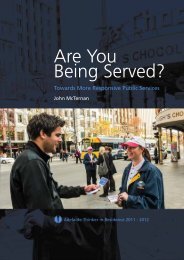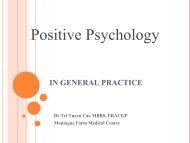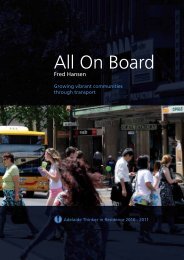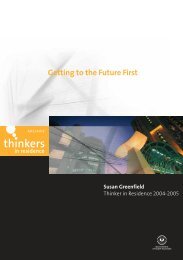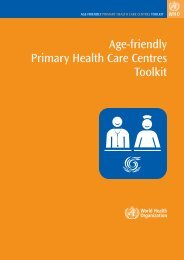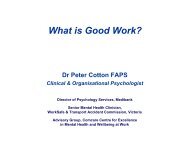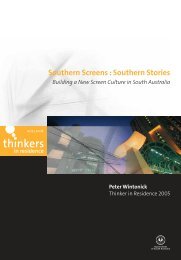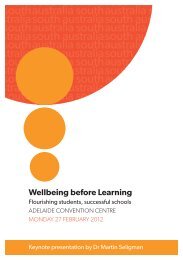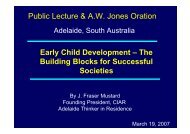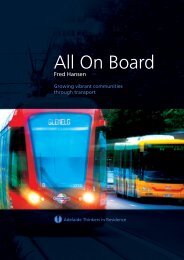Manufacturing into the future - Adelaide Thinkers in Residence - SA ...
Manufacturing into the future - Adelaide Thinkers in Residence - SA ...
Manufacturing into the future - Adelaide Thinkers in Residence - SA ...
- No tags were found...
Create successful ePaper yourself
Turn your PDF publications into a flip-book with our unique Google optimized e-Paper software.
Summary of Recommendations<strong>Manufactur<strong>in</strong>g</strong><strong><strong>in</strong>to</strong> <strong>the</strong> <strong>future</strong>Göran Roos<strong>Adelaide</strong> Th<strong>in</strong>ker <strong>in</strong> <strong>Residence</strong> 2010 - 2011GÖRAN ROOS : MANUFACTURING INTO THE FUTURE
GÖRAN ROOS : MANUFACTURING INTO THE FUTURE
<strong>Manufactur<strong>in</strong>g</strong><strong><strong>in</strong>to</strong> <strong>the</strong> <strong>future</strong>:Summary ofRecommendationsPrepared by Professor Göran Roos<strong>Adelaide</strong> Th<strong>in</strong>ker <strong>in</strong> <strong>Residence</strong> 2010–2011Department of <strong>the</strong> Premier and Cab<strong>in</strong>et C/O PO Box 2343 <strong>Adelaide</strong> <strong>SA</strong> 5001January 2012 © All rights reserved - Crown - <strong>in</strong> right of <strong>the</strong> State of South AustraliaISBN 978-0-9807470-8-9 www.th<strong>in</strong>kers.sa.gov.auGÖRAN ROOS : MANUFACTURING INTO THE FUTURE
Premier’s ForewordMessage from Jay Wea<strong>the</strong>rillS<strong>in</strong>ce <strong>the</strong> mid twentieth century, manufactur<strong>in</strong>g has been a crucial partof <strong>the</strong> South Australian economy. Start<strong>in</strong>g with <strong>the</strong> <strong>in</strong>dustries buil<strong>the</strong>re <strong>in</strong> World War Two, and cont<strong>in</strong>u<strong>in</strong>g with <strong>the</strong> <strong>in</strong>vestments madedur<strong>in</strong>g <strong>the</strong> 1950’s through <strong>the</strong> keen government support of Sir ThomasPlayford, manufactur<strong>in</strong>g grew rapidly to become one of <strong>the</strong> biggestemployers <strong>in</strong> our State, and one of our largest economic sectors.However, over <strong>the</strong> last two decades, our traditional manufactur<strong>in</strong>ghas come under <strong>in</strong>creas<strong>in</strong>g pressure from a globalised economy. Ourprevious competitive strengths, relatively cheap land and labour, haveweakened, and <strong>the</strong> high tariff wall that surrounded our <strong>in</strong>dustries hasbeen dismantled.Yet we are determ<strong>in</strong>ed that manufactur<strong>in</strong>g will be part of South Australia’s <strong>future</strong>. That is why we<strong>in</strong>vited Professor Goran Roos to become our 23rd Th<strong>in</strong>ker <strong>in</strong> <strong>Residence</strong> - to help us create a vision –and a strategy – for a renewed manufactur<strong>in</strong>g sector <strong>in</strong> South Australia.As Professor Roos noted dur<strong>in</strong>g his time here, all successful, advanced economies have strongmanufactur<strong>in</strong>g sectors. And <strong>the</strong>se sectors are strong because <strong>the</strong>y compete on value, not on cost- value that is created through <strong>in</strong>novation and advanced manufactur<strong>in</strong>g that result <strong>in</strong> high qualityproducts that can compete <strong>in</strong> a rapidly chang<strong>in</strong>g global economy.We will seize every opportunity to help our <strong>in</strong>dustries evolve <strong><strong>in</strong>to</strong> <strong>the</strong> advanced manufactur<strong>in</strong>gsector that will underp<strong>in</strong> <strong>the</strong>ir <strong>future</strong> strength. We can build on our huge advances <strong>in</strong> defence andclean technology over <strong>the</strong> past decade, and importantly, use <strong>the</strong> massive expansion of our m<strong>in</strong><strong>in</strong>g<strong>in</strong>dustry to grow advanced manufactur<strong>in</strong>g to be a sector that offers secure and fulfill<strong>in</strong>g work tomany South Australians.To start this task, <strong>the</strong> Government has prepared a <strong>Manufactur<strong>in</strong>g</strong> Green Paper which has been<strong>in</strong>spired by Roos’ recommendations and we have announced a new Advanced <strong>Manufactur<strong>in</strong>g</strong>Council which will be chaired by Professor Roos. In <strong>the</strong> second quarter of this year, we will release a<strong>Manufactur<strong>in</strong>g</strong> Strategy as a result of <strong>the</strong> Green Paper consultation.The Government welcomes Professor Roos’ report and believes that it is a useful and importantcontribution to <strong>the</strong> public debate.The Hon. Jay Wea<strong>the</strong>rillPremier of South Australia2GÖRAN ROOS : MANUFACTURING INTO THE FUTURE
Professor Göran RoosProfessor Göran Roos is one of <strong>the</strong> founders of modern <strong>in</strong>tellectualcapital science and a recognised world expert <strong>in</strong> this field. He isa highly respected adviser to government bodies <strong>in</strong> UK, Sweden,Norway, Denmark, F<strong>in</strong>land, Spa<strong>in</strong>, Austria and Australia on issuesrelat<strong>in</strong>g to strategy, research & development, national and regional<strong>in</strong>novation systems issues, knowledge management and <strong>in</strong>tellectualcapital.Göran has worked as a consultant <strong>in</strong> most OECD countries and hasserved <strong>in</strong> management positions <strong>in</strong> several European and US-basedcorporations. He presently serves as a member of <strong>the</strong> InternationalScientific Board of Valio.His extensive work around <strong>the</strong> world has <strong>in</strong>volved academic and professional work which has hadprofound impact on <strong>the</strong> development of <strong>the</strong> field of Intellectual Capital. In addition his work hashad <strong>the</strong> flow over effects of great <strong>in</strong>fluence on <strong>the</strong> development of <strong>the</strong> Graphic Art Industry <strong>in</strong>Australia, Norway and Sweden.P R O F E S S O R G Ö R A N R O O SGöran’s background also <strong>in</strong>volves work which has had a profound impact on restructur<strong>in</strong>g defenceresearch <strong>in</strong> Sweden and Austria, primary <strong>in</strong>dustries research <strong>in</strong> Australia and technical research <strong>in</strong>F<strong>in</strong>land.He is <strong>the</strong> author and co-author of numerous books and articles on Intellectual Capital, InnovationManagement and Strategy. He has authored or co-authored papers that have been named as <strong>the</strong>Literati Club Awards for Excellence Outstand<strong>in</strong>g or Highly Commended paper for <strong>the</strong> years 2002,2004, 2005 and 2007.In o<strong>the</strong>r parts of <strong>the</strong> world and particularly <strong>in</strong> Australia over <strong>the</strong> past 18 months, Göran’s teach<strong>in</strong>gand <strong>in</strong>fluence has had enormous effect on <strong>the</strong> strategic reposition<strong>in</strong>g of major firms. ProfessorGöran Roos was appo<strong>in</strong>ted <strong>Adelaide</strong> Th<strong>in</strong>ker <strong>in</strong> <strong>Residence</strong> <strong>in</strong> 2011 with a focus on <strong>Manufactur<strong>in</strong>g</strong><strong><strong>in</strong>to</strong> <strong>the</strong> Future.Professor Roos worked with ten South Australian manufactur<strong>in</strong>g companies, lead<strong>in</strong>g <strong>the</strong>m throughan <strong>in</strong>tensive program on bus<strong>in</strong>ess model <strong>in</strong>novation.The companies <strong>in</strong>volved were:• Haighs <strong>Manufactur<strong>in</strong>g</strong> Pty Ltd, Unley• Intercast & Forge Pty Ltd, W<strong>in</strong>gfield• Korvest Ltd, Kilburn• Philmac Pty Ltd, Hendon• <strong>SA</strong>GE Automation, Melrose Park• <strong>SA</strong>GE Didactic, Melrose Park• Seeley International Pty Ltd, Lonsdale• SJ Cheesman, Port Pirie• SMR Automotive Australia Pty Ltd,Lonsdale• Tytronics Developments Australia PtyLtd, HendonHis Residency <strong>in</strong>volved a diverse partner group<strong>in</strong>clud<strong>in</strong>g:• <strong>the</strong> Department of <strong>Manufactur<strong>in</strong>g</strong>,Innovation, Trade, Resources and Energy(formerly <strong>the</strong> Department of Trade andEconomic Development)• <strong>the</strong> Australian Industry Group• Innovate <strong>SA</strong>• <strong>the</strong> City of Marion• University of <strong>Adelaide</strong>• University of South Australia• Fl<strong>in</strong>ders UniversityIn parallel with this program, students and researchers from <strong>Adelaide</strong>’s three ma<strong>in</strong> universitieswere <strong>in</strong>volved <strong>in</strong> prepar<strong>in</strong>g case studies on specific areas of bus<strong>in</strong>ess development for each of <strong>the</strong>companies.GÖRAN ROOS : MANUFACTURING INTO THE FUTURE3
Objectives of <strong>the</strong> ResidencyThe framework for <strong>the</strong> Residency was a set offive broad objectives set by <strong>the</strong> partner group <strong>in</strong>collaboration with Professor Roos.Objective 1:Provide guidance <strong>in</strong> <strong>the</strong> development ofa manufactur<strong>in</strong>g <strong>in</strong>dustry strategy and animplementation plan for <strong>the</strong> strategy that<strong>in</strong>volves government and o<strong>the</strong>r partners.Objective 2:Transfer knowledge about bus<strong>in</strong>ess model<strong>in</strong>novation with an emphasis on small to mediumenterprises leav<strong>in</strong>g a cohort of ‘champions’ for<strong>the</strong> <strong>future</strong> of manufactur<strong>in</strong>g <strong>in</strong> <strong>the</strong> state.Objective 3:Assist <strong>in</strong> bridg<strong>in</strong>g <strong>the</strong> gap between researchneeded by <strong>in</strong>dustry and <strong>the</strong> <strong>in</strong>stigation ofuniversity research projects.Objective 4:Raise awareness with<strong>in</strong> <strong>the</strong> broader communityof emerg<strong>in</strong>g opportunities <strong>in</strong> a globallycompetitive manufactur<strong>in</strong>g sector and accelerate<strong>the</strong> emergence of a new manufactur<strong>in</strong>gparadigm for South Australia.Objective 5:Provide advice on <strong>the</strong> skills development neededfor modern manufactur<strong>in</strong>g.IIGÖRAN ROOS : MANUFACTURING INTO THE FUTURE
Summary ofKey F<strong>in</strong>d<strong>in</strong>gsThis section is a summary of Professor Roos’ key f<strong>in</strong>d<strong>in</strong>gs as an <strong>Adelaide</strong> Th<strong>in</strong>ker<strong>in</strong> <strong>Residence</strong>. It provides an assessment of <strong>the</strong> current state of manufactur<strong>in</strong>g<strong>in</strong> South Australia and <strong>in</strong>ternationally, outl<strong>in</strong>es <strong>the</strong> th<strong>in</strong>k<strong>in</strong>g and <strong>the</strong> rationalebeh<strong>in</strong>d Professor Roos’ recommendations and identifies <strong>the</strong> opportunitiesfor <strong>the</strong> development of <strong>the</strong> manufactur<strong>in</strong>g sector and longer term economicgrowth.A full discussion of Professor Roos’ key f<strong>in</strong>d<strong>in</strong>gs can be found <strong>in</strong> <strong>the</strong><strong>Manufactur<strong>in</strong>g</strong> <strong><strong>in</strong>to</strong> <strong>the</strong> Future Report, available onl<strong>in</strong>e atwww.th<strong>in</strong>kers.sa.gov.au.1.1 <strong>Manufactur<strong>in</strong>g</strong>, or <strong>the</strong> bus<strong>in</strong>ess of mak<strong>in</strong>g th<strong>in</strong>gs,is a critical component of any advanced economy• It is <strong>the</strong> biggest spender on applied research and <strong>in</strong>novation withspillover effects <strong><strong>in</strong>to</strong> <strong>the</strong> rest of <strong>the</strong> economy• It is <strong>the</strong> key driver of productivity improvements• It makes up <strong>the</strong> biggest share of world trade and is critical forexport earn<strong>in</strong>gs• It is <strong>the</strong> largest driver of high value services• It is <strong>the</strong> largest generator of employment, with each job <strong>in</strong>manufactur<strong>in</strong>g generat<strong>in</strong>g on average, between two and five jobs<strong>in</strong> <strong>the</strong> rest of <strong>the</strong> economy.1.2 The importance of manufactur<strong>in</strong>g has been realisedby all advanced economies, if not before, <strong>the</strong>ns<strong>in</strong>ce, <strong>the</strong> global f<strong>in</strong>ancial crisisS U M M A R Y O F K E Y F I N D I N G S• There have been several calls to action <strong>in</strong> both Europe and <strong>the</strong>United States. The shift to global manufactur<strong>in</strong>g and a last<strong>in</strong>g lackof concern for <strong>the</strong> health of <strong>the</strong> US manufactur<strong>in</strong>g sector has ledto <strong>the</strong> loss of five million manufactur<strong>in</strong>g jobs <strong>in</strong> <strong>the</strong> US s<strong>in</strong>ce 2000.Close to half of all manufactured products sold <strong>in</strong> <strong>the</strong> US today areimported; <strong>the</strong> country exports only a quarter of that volume (forwhich a large share of <strong>the</strong> <strong>in</strong>put is imported), which has led to ahuge, persistent, and grow<strong>in</strong>g trade deficit that has reached 11 %of GDP.• The countries that have recovered best from <strong>the</strong> global f<strong>in</strong>ancialcrisis are all based around high value-added export orientedmanufactur<strong>in</strong>g (Austria, Denmark, F<strong>in</strong>land, Germany, Ne<strong>the</strong>rlands,Sweden and Switzerland). These European manufactur<strong>in</strong>g beltcountries are all do<strong>in</strong>g well <strong>in</strong> spite of <strong>the</strong> Global F<strong>in</strong>ancial Crisis and<strong>the</strong> Euro Crisis.• Ch<strong>in</strong>ese growth is also primarily based on manufactur<strong>in</strong>g, of whicharound 15% is exported.GÖRAN ROOS : MANUFACTURING INTO THE FUTURE5
“A healthy manufactur<strong>in</strong>g sector is a must for anyadvanced economy with ambitions to ma<strong>in</strong>ta<strong>in</strong>economic and social wellbe<strong>in</strong>g.”Professor Göran Roos, 20111.3 <strong>Manufactur<strong>in</strong>g</strong> is chang<strong>in</strong>g• Technology enabled developments are chang<strong>in</strong>g <strong>the</strong> nature of manufactur<strong>in</strong>g to anextent where exist<strong>in</strong>g statistics are becom<strong>in</strong>g unreliable – primarily relat<strong>in</strong>g to <strong>the</strong>grow<strong>in</strong>g provision of services and solutions from manufactur<strong>in</strong>g firms. Correct<strong>in</strong>g for<strong>the</strong>se statistical omissions leads us to conclude that <strong>the</strong> bus<strong>in</strong>ess of mak<strong>in</strong>g th<strong>in</strong>gs -<strong>in</strong>clud<strong>in</strong>g services and solutions provided by manufactur<strong>in</strong>g firms - probably represents,as a share of GDP, more than 30% of an advanced (or <strong>in</strong>novation) economy. A goodillustration is Ericsson – <strong>the</strong> world’s lead<strong>in</strong>g provider of telecommunication <strong>in</strong>frastructureproducts, services and solutions – of <strong>the</strong>ir 98,000 employees around 22,000 work<strong>in</strong> research and development, 50,000 <strong>in</strong> services and solutions and <strong>the</strong> rema<strong>in</strong>der <strong>in</strong>production and adm<strong>in</strong>istration.• The emergence of digital and additive manufactur<strong>in</strong>g, biotechnology enabledmanufactur<strong>in</strong>g and nanotechnology enabled manufactur<strong>in</strong>g is chang<strong>in</strong>g <strong>the</strong> form ofmanufactur<strong>in</strong>g <strong>in</strong> ways that can most easily be described as a new <strong>in</strong>dustrial revolutionthat will impact virtually all manufactur<strong>in</strong>g related activities.• Design based <strong>in</strong>novation [<strong>the</strong> ability to change customer and consumer behaviour]drives rapid shifts <strong>in</strong> <strong>in</strong>dustry profit pool shares.• Bus<strong>in</strong>ess model based <strong>in</strong>novation enables <strong>the</strong> appropriation of a higher share of <strong>the</strong>value created and hence <strong>in</strong>creases profitability dramatically.The two latter po<strong>in</strong>ts are exemplified by Apple’s iPhone.1.4 South Australia is a small economy• A small economy does not have <strong>the</strong> opportunity of a large economy to spontaneouslygenerate optimal responses to change. Left to its own devices, compared to a largeeconomy, <strong>the</strong> small economy as a whole has a higher risk of decl<strong>in</strong>e unless <strong>the</strong>re isoutside <strong>in</strong>tervention. To express it <strong>in</strong> neo-classical economic term<strong>in</strong>ology: The smaller<strong>the</strong> economy <strong>the</strong> more pervasive market failure is, as an attribute of <strong>the</strong> economy as awhole.• S<strong>in</strong>ce access to both new knowledge and lead customers is both more probable andmore cost effective <strong>in</strong> a large economy, it is likely that a firm will, over time, movefrom a smaller economy to a larger one. This relocation decision is also impacted by<strong>the</strong> ownership structure of <strong>the</strong> firm. If <strong>the</strong> decision mak<strong>in</strong>g power rests with a groupof diverse economic actors with no location preference, it is more likely that <strong>the</strong>y willrelocate <strong>the</strong> company to a larger economy. Whereas, if a firm is owned by an <strong>in</strong>dividualor family, strongly connected to <strong>the</strong>ir community, <strong>the</strong>ir decision about <strong>the</strong> location of<strong>the</strong> firm may not be made purely on economic criteria. This means that <strong>the</strong> need forproactive government <strong>in</strong>tervention <strong>in</strong> <strong>the</strong> form of <strong>in</strong>dustry, <strong>in</strong>novation and researchpolicy is very high, <strong>in</strong> order to ensure a strong, diversified and locally embeddedmanufactur<strong>in</strong>g sector <strong>in</strong> <strong>SA</strong>.6GÖRAN ROOS : MANUFACTURING INTO THE FUTURE
1.5 South Australia needs a more balanced manufactur<strong>in</strong>g sector• Accord<strong>in</strong>g to IBIS World data w<strong>in</strong>e, iron, steel, copper, silver, lead and z<strong>in</strong>cmanufactur<strong>in</strong>g have a turnover equal to <strong>the</strong> rest of South Australia’s manufactur<strong>in</strong>g<strong>in</strong>dustry comb<strong>in</strong>ed. A rebalanc<strong>in</strong>g is needed to reduce <strong>the</strong> state’s economic risk and toenable <strong>the</strong> state to benefit from any rapidly emerg<strong>in</strong>g opportunities, for example, <strong>the</strong>resources boom.• Without a manufactur<strong>in</strong>g strategy South Australia will not have a diverse and capablemanufactur<strong>in</strong>g sector. A well-balanced and capable manufactur<strong>in</strong>g sector shouldbe able to convert <strong>the</strong> comparative advantages represented by local resources, forexample, m<strong>in</strong>erals, wheat, grapes, apples, wood and wool <strong><strong>in</strong>to</strong> competitive advantages.Without such a balanced and capable manufactur<strong>in</strong>g sector, <strong>the</strong>re is a risk of SouthAustralia experienc<strong>in</strong>g <strong>the</strong> surpris<strong>in</strong>gly strong downside of a resources boom.• Compared with lead<strong>in</strong>g manufactur<strong>in</strong>g nations South Australia needs to <strong>in</strong>crease <strong>the</strong>value add and productivity <strong>in</strong> manufactur<strong>in</strong>g firms. This is frequently enabled through<strong>in</strong>vestments <strong>in</strong> <strong>in</strong>tangibles like tra<strong>in</strong><strong>in</strong>g, digitalisation of operations, research anddevelopment.1.6 As part of <strong>the</strong> Australian national resources boom South Australiais on <strong>the</strong> threshold of develop<strong>in</strong>g Dutch DiseaseS U M M A R Y O F K E Y F I N D I N G S• Dutch Disease can be characterised by:- An <strong>in</strong>creas<strong>in</strong>g demand for labour from <strong>the</strong> boom<strong>in</strong>g resources sector, result<strong>in</strong>g <strong>in</strong> aproduction shift from <strong>the</strong> manufactur<strong>in</strong>g and service (or non-traded) sectors to <strong>the</strong>resources sector. This effect, although visible, is not normally a major problem s<strong>in</strong>ce<strong>the</strong> boom<strong>in</strong>g sector is capital <strong>in</strong>tensive ra<strong>the</strong>r than labour <strong>in</strong>tensive and hence doesnot employ a large number of people as a share of <strong>the</strong> total economy.- The extra revenue generated by <strong>the</strong> boom<strong>in</strong>g sector results <strong>in</strong> a spend<strong>in</strong>g effect whichtakes <strong>the</strong> form of <strong>in</strong>creased demand for offer<strong>in</strong>gs from <strong>the</strong> services (or non-traded)sector. This <strong>in</strong>creased demand moves labour away from <strong>the</strong> manufactur<strong>in</strong>g sector.- Increased demand for non-traded goods (or services) results <strong>in</strong> <strong>in</strong>creased pricesfor <strong>the</strong>se goods. This is to be compared with <strong>the</strong> prices of <strong>the</strong> goods <strong>in</strong> <strong>the</strong>manufactur<strong>in</strong>g sector which are set <strong>in</strong>ternationally and hence cannot change as aconsequence of changes <strong>in</strong> domestic conditions. This outcome can be seen <strong>in</strong> <strong>the</strong>form of an <strong>in</strong>crease <strong>in</strong> purchas<strong>in</strong>g power of <strong>the</strong> domestic currency relative to o<strong>the</strong>rcurrencies.• Allow<strong>in</strong>g a shift away from manufactur<strong>in</strong>g will be detrimental to <strong>the</strong> long-termwellbe<strong>in</strong>g of <strong>the</strong> State. It takes longer and is much more complex and costly to rebuilda competitive manufactur<strong>in</strong>g <strong>in</strong>dustry than it is allow<strong>in</strong>g it to die. A case can bemade that <strong>the</strong> cost of rega<strong>in</strong><strong>in</strong>g a lost competitive manufactur<strong>in</strong>g sector can be higherthan <strong>the</strong> net ga<strong>in</strong>s from <strong>the</strong> resource boom. This is due to <strong>the</strong> relatively lower speed oftechnology growth <strong>in</strong> <strong>the</strong> boom<strong>in</strong>g resource sector and <strong>the</strong> services (non-traded goods)sector as compared to <strong>the</strong> manufactur<strong>in</strong>g (traded goods) sector.• There are two means to reduce <strong>the</strong> risk of Dutch Disease. The first is to slow down <strong>the</strong>appreciation of <strong>the</strong> real exchange rate (this is a federal issue and is <strong>the</strong>refore outside of<strong>the</strong> objectives of this Residency). The second is to <strong>in</strong>crease <strong>the</strong> competitiveness of <strong>the</strong>manufactur<strong>in</strong>g sector. This will require a number of simultaneous actions, for example:- <strong>in</strong>vestment <strong>in</strong> education aimed at and for <strong>the</strong> manufactur<strong>in</strong>g sector- <strong>in</strong>vestment <strong>in</strong> <strong>in</strong>frastructure benefit<strong>in</strong>g <strong>the</strong> manufactur<strong>in</strong>g sector- encourag<strong>in</strong>g <strong>in</strong>novation <strong>in</strong> <strong>the</strong> manufactur<strong>in</strong>g sector through <strong>the</strong> implementation ofdemand side policy toolsGÖRAN ROOS : MANUFACTURING INTO THE FUTURE7
• One of <strong>the</strong> weaknesses that needs to be addressed on <strong>the</strong> firm level, is managerialcapability. Studies show that Australia is mediocre <strong>in</strong> its managerial capability. In effect,27% of Ch<strong>in</strong>ese and Indian firms are more capably managed than half of Australianfirms. (Source: Management Matters Data Set. For fur<strong>the</strong>r survey work see Nick Bloomand John Feenen, ‘Measur<strong>in</strong>g and Expla<strong>in</strong><strong>in</strong>g Management Practices across firms andCountries’, Quarterly Journal of Economics, November 2007; Australian ManagementPractices Research; as presented by Professor Roy Green at <strong>the</strong> Australian Camber’sBus<strong>in</strong>ess Congress <strong>in</strong> June 2011)• The importance of this is fur<strong>the</strong>r highlighted by <strong>the</strong> <strong>in</strong>creased direct competition aris<strong>in</strong>gfrom <strong>the</strong> Ch<strong>in</strong>ese and Indian manufactur<strong>in</strong>g sectors mov<strong>in</strong>g to <strong>in</strong>creas<strong>in</strong>gly sophisticatedlevels of production. In addition, as a consequence of fur<strong>the</strong>r development andadoption of <strong>in</strong>formation and communications-related technologies, structural changeswill result from parts of <strong>the</strong> services (non-traded) sector becom<strong>in</strong>g traded.“The role of Government <strong>in</strong> ensur<strong>in</strong>g <strong>the</strong> <strong>future</strong>of <strong>the</strong> manufactur<strong>in</strong>g sector, <strong>in</strong> a small economyshow<strong>in</strong>g early signs of Dutch Disease, is critical.”Professor Göran Roos, 20111.7 The resources boom may be shorter than generally believedamong decision makersThis is due to:• Technology developments that make it possible to have economic growth withoutgrowth <strong>in</strong> resource use – sometimes called “<strong>the</strong> green<strong>in</strong>g of <strong>the</strong> economy”. Sweden hasachieved absolute decoupl<strong>in</strong>g of <strong>in</strong>creas<strong>in</strong>g GDP and greenhouse gas emissions from1995 onwards. [1]• Consumers vot<strong>in</strong>g with <strong>the</strong>ir wallets and <strong>the</strong>ir feet. There is global consumer andpolitical pressure on closed-loop low-resource-footpr<strong>in</strong>t manufactur<strong>in</strong>g systems, forexample, us<strong>in</strong>g <strong>the</strong> waste of one process as <strong>the</strong> <strong>in</strong>put for ano<strong>the</strong>r process . This is called‘Industrial symbiosis’. Good examples of emerg<strong>in</strong>g <strong>in</strong>dustrial symbiosis clusters can befound <strong>in</strong> Kalundborg <strong>in</strong> Denmark and Kw<strong>in</strong>ana, south of Perth.• Global regulatory pressure and penalty risk exposure. There seems to be a lack ofappreciation of Australia’s risk exposure if it is not seen to take early steps to manageits carbon impact. Australia cannot afford to be too late <strong>in</strong> this doma<strong>in</strong>, especially if itis seen to avoid negative economic impacts through rapid expansion of its domesticand <strong>in</strong>ternational carbon footpr<strong>in</strong>ts. The consequence is that when <strong>in</strong>ternationalagreement <strong>in</strong> <strong>the</strong> carbon footpr<strong>in</strong>t doma<strong>in</strong> is reached between <strong>the</strong> OECD (Organisationfor Economic Co-operation and Development) countries and <strong>the</strong> BRICS (Brazil, Russia,India, Ch<strong>in</strong>a and South Africa) countries, Australia risks be<strong>in</strong>g sacrificed. This could be <strong>in</strong><strong>the</strong> form of export taxes based on <strong>the</strong> carbon <strong>in</strong>tensity of <strong>the</strong> Australian economy andits carbon footpr<strong>in</strong>t. It is, among o<strong>the</strong>r th<strong>in</strong>gs, aga<strong>in</strong>st this backdrop that <strong>the</strong> carbon taxshould be seen.This means that <strong>the</strong> value of any discovered resources will decrease <strong>in</strong> an accelerat<strong>in</strong>g way overtime and should be exploited early to maximise <strong>the</strong>ir value. It is essential that <strong>the</strong> exploitation ofresources is complemented with associated manufactur<strong>in</strong>g <strong>in</strong>dustry development.[1] Mollerston, K et al. (2005) ‘Swedish Report on Demonstrable Progress’, to <strong>the</strong> COP1/MOP 1 UNFCCC meet<strong>in</strong>g8GÖRAN ROOS : MANUFACTURING INTO THE FUTURE
1.8 The South Australian policy environment needs to bestreng<strong>the</strong>ned substantially• Economic development should be at <strong>the</strong> centre of any government’s agenda.Without <strong>the</strong> revenue provided to government through economic activity, no spend<strong>in</strong>gdependent policies are possible.• Any economic value creation policy requires a framework beyond a balanced budget.• Demand side tools like procurement, cluster <strong>in</strong>itiatives (<strong>in</strong>clud<strong>in</strong>g <strong>in</strong>dustry participationpolicies) and regulation drive outcomes and are currently underutilised. All threedemand side tools are critical, widely used and well proven <strong>in</strong> <strong>the</strong> OECD world where<strong>the</strong>y have been shown to deliver very good outcomes. The present focus is on supplyside tools that only drive activity.• Policy development must be grounded <strong>in</strong> a good factual understand<strong>in</strong>g of <strong>the</strong> presentsituation based on reliable data. The lack of reliable data is presently a problem <strong>in</strong>South Australia.• Policy development must be grounded <strong>in</strong> a clear and constantly updated view of <strong>the</strong><strong>future</strong> us<strong>in</strong>g, for example, technology roadmaps.• Policies should be developed relat<strong>in</strong>g to <strong>the</strong> follow<strong>in</strong>g key <strong>in</strong>dustry policy doma<strong>in</strong>sa. Transform<strong>in</strong>g a mature or decl<strong>in</strong><strong>in</strong>g <strong>in</strong>dustry that is very large <strong>in</strong> terms ofemployees, turnover, geographical dispersion, systemic impact or tax contribution(e.g. firms <strong>in</strong> <strong>the</strong> automotive supply cha<strong>in</strong>; firms <strong>in</strong> <strong>the</strong> defence supply cha<strong>in</strong>).S U M M A R Y O F K E Y F I N D I N G Sb. Rejuvenat<strong>in</strong>g a mature or decl<strong>in</strong><strong>in</strong>g <strong>in</strong>dustry that is very large <strong>in</strong> terms ofemployees, turnover, geographical dispersion, systemic impact or tax contribution(e.g. W<strong>in</strong>e; Forestry, Paper and Pulp).c. Grow<strong>in</strong>g an exist<strong>in</strong>g <strong>in</strong>dustry grounded <strong>in</strong> both comparative and competitiveadvantages with positive outlooks for its share of global bus<strong>in</strong>ess (e.g. Food; firms<strong>in</strong> <strong>the</strong> m<strong>in</strong><strong>in</strong>g supply cha<strong>in</strong>).d. Build<strong>in</strong>g an <strong>in</strong>dustry grounded <strong>in</strong> <strong>future</strong> comparative and competitive advantageswith positive outlooks for its share of global bus<strong>in</strong>ess (e.g. Functional Food;Scientific Instruments).• Special projects are <strong>in</strong>stigated relat<strong>in</strong>g to key urgent opportunities, to ensure that <strong>the</strong>economic benefit to <strong>the</strong> State is maximised.In South Australia, <strong>the</strong>se opportunities could relate to:• Develop<strong>in</strong>g and execut<strong>in</strong>g an <strong>in</strong>dustry participation policy around build<strong>in</strong>g m<strong>in</strong><strong>in</strong>grelated clusters, centred on resource extraction opportunities. Development of <strong>the</strong>policy could be undertaken by a work<strong>in</strong>g group <strong>in</strong>volv<strong>in</strong>g <strong>the</strong> key stakeholders anddraw<strong>in</strong>g on <strong>the</strong> Ontario, Hebron project <strong>in</strong> Newfoundland and Norwegian examples.• Develop and execute a policy around Tonsley Park, draw<strong>in</strong>g on <strong>in</strong>dustrial ecology/symbiosis pr<strong>in</strong>ciples and l<strong>in</strong>ks with o<strong>the</strong>r <strong>in</strong>dustry policy doma<strong>in</strong>s e.g. <strong>the</strong> m<strong>in</strong><strong>in</strong>grelated cluster <strong>in</strong>itiatives.• Industrial triage, or ‘corporate welfare’ activities should be by exceptions, short livedand only acceptable if a clear transformation or rejuvenation policy is established andassociated actions committed to by <strong>the</strong> receiv<strong>in</strong>g firms. Industrial triage activities shouldbe transparent and publically reported.GÖRAN ROOS : MANUFACTURING INTO THE FUTURE9
10GÖRAN ROOS : MANUFACTURING INTO THE FUTURE
Summary ofRecommendationsEconomic philosophy underp<strong>in</strong>n<strong>in</strong>g <strong>the</strong>recommendationsThe prospects for deal<strong>in</strong>g effectively with <strong>the</strong> structural problems fac<strong>in</strong>g <strong>the</strong>manufactur<strong>in</strong>g sector are bleak, as long as traditional neoclassical economicpr<strong>in</strong>ciples dom<strong>in</strong>ate economic growth policy. Despite a grow<strong>in</strong>g critique of <strong>the</strong>efficient market hypo<strong>the</strong>sis <strong>in</strong> academic circles from <strong>the</strong> 1970s, which reacheda peak <strong>in</strong> <strong>the</strong> mid 1990s, it stayed <strong>the</strong> dom<strong>in</strong>at<strong>in</strong>g paradigm until <strong>the</strong> first dot.com-bubble <strong>in</strong> around 2000 when it started to be generally criticised. S<strong>in</strong>ce<strong>the</strong> global f<strong>in</strong>ancial crisis <strong>in</strong> 2008, <strong>the</strong> efficient market hypo<strong>the</strong>sis has beenwidely rejected as unrealistic <strong>in</strong> its assumptions and governments have begunreplac<strong>in</strong>g it with behavioural economics as <strong>the</strong> underly<strong>in</strong>g <strong>the</strong>ory for publicpolicy.1: Replace <strong>the</strong> efficient market hypo<strong>the</strong>sis with behaviouraleconomics as a philosophical basis for government policy.Industry, Innovation and Research Policy –<strong>the</strong> foundation of a thriv<strong>in</strong>g and susta<strong>in</strong>ablemanufactur<strong>in</strong>g sectorS U M M A R Y O F R E C O M M E N D A T I O N SIndustry, <strong>in</strong>novation and research policies are aimed at <strong>in</strong>creas<strong>in</strong>g nationalwellbe<strong>in</strong>g by maximis<strong>in</strong>g economic value creation under <strong>the</strong> constra<strong>in</strong>tsof m<strong>in</strong>imum environmental and resource use and impact, comb<strong>in</strong>ed withmaximum positive social and public good effects.2: Develop an <strong>in</strong>tegrated Industrial, Innovation and Research Policy.3: Establish a South Australian Industry, Innovation & ResearchPolicy Council.Policy formulation on <strong>the</strong> macro-economic level sits at <strong>the</strong> Cab<strong>in</strong>et/M<strong>in</strong>isteriallevel. Individual Departments are <strong>the</strong>n responsible for identify<strong>in</strong>g and deliver<strong>in</strong>g<strong>the</strong> meso-level policies and strategies. Some of <strong>the</strong>se meso-level policies andstrategies are <strong>the</strong>n broken down <strong><strong>in</strong>to</strong> micro-level strategies and programs whichare implemented by <strong>the</strong> departments’ delivery agencies.4: Establish clear objectives and responsibilities on <strong>the</strong> macroand meso level for DMITRE and o<strong>the</strong>r departments as relatesto <strong>the</strong> <strong>in</strong>dustry, <strong>in</strong>novation and research policy. Establish clear,transparent and cont<strong>in</strong>uous evaluation systems for <strong>the</strong>seobjectives and responsibilities.5: DMITRE should articulate <strong>the</strong> micro-level objectives for itsdelivery agencies and establish a clear and transparentevaluation system for <strong>the</strong>se agencies.6: Map <strong>the</strong> <strong>in</strong>dustry landscape <strong>in</strong> order to enable fact based policymak<strong>in</strong>g <strong>in</strong> <strong>the</strong> <strong>in</strong>dustry doma<strong>in</strong>.GÖRAN ROOS : MANUFACTURING INTO THE FUTURE11
7: Identify <strong>the</strong> 15% growth oriented SME’s and target programs and activities at<strong>the</strong>m.8: Operationalise <strong>the</strong> suggested policy objectives by sector, once <strong>the</strong> <strong>in</strong>dustrylandscape is mapped out.9: Identify <strong>the</strong> targeted <strong>in</strong>dustry policy sectors along <strong>the</strong> follow<strong>in</strong>g dimensions:a. Transform<strong>in</strong>g a mature or decl<strong>in</strong><strong>in</strong>g <strong>in</strong>dustry that is very large <strong>in</strong> terms of employees,turnover, geographical dispersion, systemic impact or tax contribution (e.g. firms <strong>in</strong> <strong>the</strong>automotive supply cha<strong>in</strong>; firms <strong>in</strong> <strong>the</strong> defence supply cha<strong>in</strong>).b. Rejuvenat<strong>in</strong>g a mature or decl<strong>in</strong><strong>in</strong>g <strong>in</strong>dustry that is very large <strong>in</strong> terms of employees,turnover, geographical dispersion, systemic impact or tax contribution (e.g. W<strong>in</strong>e;Forestry, Paper and Pulp).c. Grow<strong>in</strong>g an exist<strong>in</strong>g <strong>in</strong>dustry grounded <strong>in</strong> both comparative and competitiveadvantages with positive outlooks for its share of global bus<strong>in</strong>ess (e.g. Food; firms <strong>in</strong> <strong>the</strong>m<strong>in</strong><strong>in</strong>g supply cha<strong>in</strong>).d. Build<strong>in</strong>g an <strong>in</strong>dustry grounded <strong>in</strong> <strong>future</strong> comparative and competitive advantageswith positive outlooks for its share of global bus<strong>in</strong>ess (e.g. Functional Food; ScientificInstruments).10: Put <strong>in</strong> place a voucher system for SME’s to encourage <strong>the</strong>m to l<strong>in</strong>k withuniversities, TAFEs, research and technology organisations and public and privateproviders for problem solv<strong>in</strong>g purposes. The purpose of <strong>the</strong> voucher is to enable<strong>the</strong> firm to beg<strong>in</strong> address<strong>in</strong>g a problem that it cannot solve on its own and forwhich <strong>the</strong>re is no obvious solution available of-<strong>the</strong>-shelf. The objective is not that<strong>the</strong> problem should be solved but ra<strong>the</strong>r that <strong>the</strong> firm can see that it is possible tosolve <strong>the</strong> problem through work<strong>in</strong>g with <strong>the</strong> provider. In o<strong>the</strong>r words <strong>the</strong> purposeis to foster productive l<strong>in</strong>kages <strong>in</strong> <strong>the</strong> <strong>in</strong>novation system.Policy InstrumentsPolicy <strong>in</strong>struments are <strong>the</strong> tools which can be used to overcome problems and achieve objectives.The available policy <strong>in</strong>struments are only limited by <strong>the</strong> law of <strong>the</strong> land, political acceptability and<strong>the</strong> <strong>in</strong>novativeness of <strong>the</strong> policy development team. The fundamental difference between supplyside and demand side policy tools is that <strong>the</strong> supply side policy tools tend to drive activity whiledemand side policy tools tend to drive outcomes. Demand side policy tools <strong>in</strong>clude procurement,regulation and clusters and research from <strong>the</strong> European Union suggests that demand side policytools are between 50% and 100% more effective as drivers of <strong>in</strong>novation.11: Ensure a balanced use of policy tools from both <strong>the</strong> supply side (primarily forresearch policy use) and <strong>the</strong> demand side (for <strong>in</strong>novation and <strong>in</strong>dustrial policy use).Demand side policy tools: RegulationRegulation can be a powerful tool to drive <strong>in</strong>novation with<strong>in</strong> specific sectors (e.g. construction)and technologies (e.g. green technologies). Although <strong>in</strong>novation is a ra<strong>the</strong>r important impactdimension of regulation, its explicit appearance with<strong>in</strong> regulation is ra<strong>the</strong>r limited. An analysis of<strong>the</strong> objectives and missions of <strong>in</strong>stitutions and bodies responsible for regulatory policies <strong>in</strong> <strong>the</strong>European Union, <strong>the</strong> U<strong>SA</strong> and Japan revealed that for those bodies responsible for competitionissues, or operat<strong>in</strong>g <strong>in</strong> very dynamic sectors such as telecommunications, <strong>the</strong> promotion of<strong>in</strong>novation is stated as an objective.12GÖRAN ROOS : MANUFACTURING INTO THE FUTURE
12: South Australian regulatory bodies responsible, for example, for <strong>the</strong> protection ofcompetition, health and safety or <strong>the</strong> environment, have to adequately consider<strong>the</strong> opportunities of <strong>in</strong>novation <strong>in</strong> general for achiev<strong>in</strong>g <strong>the</strong>ir stated goals.13: South Australian regulatory bodies have to become more proactive <strong>in</strong> identify<strong>in</strong>g<strong>the</strong> trends <strong>in</strong> science and technology relevant for <strong>the</strong>ir regulatory framework by:• <strong>in</strong>tensify<strong>in</strong>g contact with <strong>the</strong> science and technology communities• implement<strong>in</strong>g “regulatory foresight” exercises• observ<strong>in</strong>g on-go<strong>in</strong>g standardisation processes elsewhere.14: South Australian regulatory bodies have to focus on those types of regulation,or shape regulation, <strong>in</strong> a way which maximises <strong>the</strong> positive and m<strong>in</strong>imises <strong>the</strong>negative impacts for <strong>the</strong> development and market <strong>in</strong>troduction of <strong>in</strong>novations.15: The performance criteria of South Australian regulatory bodies have to <strong>in</strong>tegrate<strong>in</strong>dicators measur<strong>in</strong>g <strong>the</strong> promotion of new products and services <strong>in</strong> balance with<strong>the</strong>ir o<strong>the</strong>r objectives.16: S<strong>in</strong>ce <strong>in</strong>novation is a complex process, <strong>the</strong> promotion of <strong>in</strong>novation by SouthAustralian regulatory policies requires a comprehensive approach, co-ord<strong>in</strong>at<strong>in</strong>g oreven <strong>in</strong>tegrat<strong>in</strong>g <strong>the</strong> regulatory policies of all <strong>the</strong> regulatory bodies.17: The implementation of regulation has to be consistent across agencies <strong>in</strong> order toreduce <strong>the</strong> risk and <strong>the</strong> costs to companies <strong>in</strong>troduc<strong>in</strong>g <strong>in</strong>novations.18: Shap<strong>in</strong>g <strong>the</strong> regulatory framework for new products and services should alsotake <strong><strong>in</strong>to</strong> account w<strong>in</strong>dows of opportunities to establish lead markets which maygenerate trade advantages and are <strong>the</strong>refore a source of <strong>future</strong> growth.S U M M A R Y O F R E C O M M E N D A T I O N S19: Approval times have to be reduced, s<strong>in</strong>ce <strong>the</strong>y negatively impact <strong>the</strong> expectedreturn on <strong>in</strong>vestment <strong>in</strong> long-last<strong>in</strong>g and expensive research and development thatresults <strong>in</strong> <strong>in</strong>novative products and services.Demand side policy tools: ProcurementPublic procurement is an area of great economic, political and legal significance, <strong>in</strong>volv<strong>in</strong>ggovernments at various levels buy<strong>in</strong>g goods and services from private firms, <strong>the</strong>reby represent<strong>in</strong>g asignificant proportion of economic activity <strong>in</strong> most jurisdictions. Public procurement cannot only bea means of deliver<strong>in</strong>g policy, it can be used as a key <strong>in</strong>strument <strong>in</strong> economic and social change.While acknowledg<strong>in</strong>g that <strong>the</strong> <strong>in</strong>herent complexity of multiple procurement policy objectives maysometimes be <strong>in</strong> tension, public procurement has significant positive effects on <strong>in</strong>novation successand <strong>the</strong> contribution of <strong>in</strong>novation (technology based, design based and bus<strong>in</strong>ess model based) toeconomic development is undisputed.20: Establish a South Australian version of <strong>the</strong> United States’ Small Bus<strong>in</strong>essInnovation Research (SBIR) program draw<strong>in</strong>g on <strong>the</strong> UK experience.21: Ensure coord<strong>in</strong>ation of procurement objectives <strong>in</strong> <strong>in</strong>dividual m<strong>in</strong>isterial doma<strong>in</strong>swith <strong>the</strong> <strong>in</strong>dustry, <strong>in</strong>novation and research policy objectives to ensure maximumnet present value returns to <strong>the</strong> economy.22: Develop an evaluation mechanism for larger procurement projects.GÖRAN ROOS : MANUFACTURING INTO THE FUTURE13
23: Develop competence and processes that enables <strong>the</strong> deployment of procurementas a demand side policy tool for Industry, <strong>in</strong>novation and research policy objectives.This <strong>in</strong>volves, for example, life cycle cost procurement and procur<strong>in</strong>g beyondexist<strong>in</strong>g offer<strong>in</strong>gs.24: Develop specific procurement policies to support <strong>the</strong> <strong>in</strong>dustry, <strong>in</strong>novation andresearch policies accord<strong>in</strong>g to <strong>the</strong> two dimensions of societal need and marketdevelopment.25: Develop a Lead Market Initiative around Industry, Innovation and research doma<strong>in</strong>sdraw<strong>in</strong>g on experience ga<strong>in</strong>ed from F<strong>in</strong>land and <strong>the</strong> UK, and underp<strong>in</strong> <strong>the</strong>se withappropriate procurement policy tools as demand side drivers.26: Implement a South Australian version of <strong>the</strong> UK’s successful <strong>in</strong>ternet-based publicprocurement system for contracts up to about A$100k.27: With<strong>in</strong> specific procurements <strong>the</strong>re needs to be an efficient and effective means ofmanag<strong>in</strong>g procurement that aligns with current bus<strong>in</strong>ess practice. The UK’s SMARTprocurement system offers such an approach and has established a track record ofdeal<strong>in</strong>g with requirements creep, cost over-run and delay. This should be adoptedand adapted for use <strong>in</strong> South Australia.28: Develop a pr<strong>in</strong>ciple around <strong>in</strong>tellectual property rights that results <strong>in</strong> <strong>the</strong><strong>in</strong>tellectual property developed <strong>in</strong> a project be<strong>in</strong>g handed to <strong>the</strong> party with <strong>the</strong>best opportunities and capabilities to commercialise it fur<strong>the</strong>r.29: Develop a risk-based framework around procurement that underp<strong>in</strong>s <strong>the</strong> type ofprocurement situation to be managed. [A framework is provided <strong>in</strong> Professor Roos’ fullreport available onl<strong>in</strong>e at www.th<strong>in</strong>kers.sa.gov.au]Demand side policy tools: Clusters / EcosystemsEconomic activities tend to agglomerate <strong>in</strong> time and space which can result <strong>in</strong> benefits for<strong>in</strong>dividual firms and an economy more broadly. There are four types of economic agglomerations,three of which are highlighted here.The first is Cities: when all firms benefit from be<strong>in</strong>g <strong>in</strong> a s<strong>in</strong>gle location. These benefits lead to<strong>the</strong> emergence and growth of metropolitan regions and <strong>the</strong> centralisation of specific activities forexample, manufactur<strong>in</strong>g belts. A subset of this agglomeration is <strong>the</strong> so-called Knowledge Citywhich is characterised by: high levels of economic success and knowledge <strong>in</strong>tensity; a diverse<strong>in</strong>dustry base <strong>in</strong>clud<strong>in</strong>g dist<strong>in</strong>ctive specialist niches and a tertiary education sector that has amutually beneficial relationship with <strong>the</strong> city, lead<strong>in</strong>g to <strong>in</strong>dustries based on research strengths,knowledge transfer to bus<strong>in</strong>esses and <strong>the</strong> retention of graduates.30: Develop a Knowledge City strategy with associated actions for <strong>Adelaide</strong>.The second is Creative Regions which refers to knowledge creation <strong>in</strong> a region that is not sectorspecific. This occurs due to <strong>the</strong> presence of a variety of skills and competencies that <strong>in</strong>teract <strong>in</strong>an unplanned manner and hence generate new and often unforeseen knowledge that can beembodied <strong>in</strong> product-service-systems, designs and bus<strong>in</strong>ess models.31: Develop a Creative Region strategy with associated actions for on <strong>the</strong> one hand<strong>the</strong> City of Marion/McLaren Vale/ Fleurieu pen<strong>in</strong>sula region and on <strong>the</strong> o<strong>the</strong>r hand<strong>the</strong> North <strong>Adelaide</strong>/<strong>Adelaide</strong> Hills/Barossa Region.Clusters refers to a group of l<strong>in</strong>ked actors (firms, f<strong>in</strong>ancial actors, public actors, universities, media,etc.) where <strong>the</strong> group’s susta<strong>in</strong>able competitive advantage is grounded <strong>in</strong> resources (monetary,physical, relational, organisational and human) l<strong>in</strong>ked to a particular location.14GÖRAN ROOS : MANUFACTURING INTO THE FUTURE
There is substantial evidence to suggest that <strong>in</strong>novation and economic growth are heavilygeographically concentrated so clusters provide an environment that is conducive to both<strong>in</strong>novation and knowledge creation.32: Develop a set of cluster <strong>in</strong>itiatives focused around Greater <strong>Adelaide</strong>:• Food/w<strong>in</strong>e and agri-tourism• Equipment and services for <strong>the</strong> m<strong>in</strong><strong>in</strong>g sector• Closed loop and low resource footpr<strong>in</strong>t production processes.33: Reconstruct <strong>the</strong> Automotive Cluster draw<strong>in</strong>g on successful case examples.34: Develop and execute a policy around build<strong>in</strong>g a m<strong>in</strong><strong>in</strong>g cluster centered around <strong>the</strong>large resource companies draw<strong>in</strong>g on <strong>the</strong> Ontario and Norwegian examples.The role of universities <strong>in</strong> <strong>the</strong> <strong>in</strong>novation systemThe role of universities <strong>in</strong> <strong>the</strong> <strong>in</strong>novation system is a complex but important one. Universities area source of highly educated people and a major source of new ideas. Along with <strong>the</strong>ir teach<strong>in</strong>gand research activities, <strong>the</strong>y attract new knowledge and resources from external sources and adaptexist<strong>in</strong>g knowledge to local conditions.35: De-emphasise <strong>the</strong> commercialisation of <strong>in</strong>tellectual property at universities and deemphasise<strong>the</strong> focus on start-ups by academics without student participation.36: Encourage universities and TAFE’s to establish a path for promot<strong>in</strong>g start-up firmsby students.S U M M A R Y O F R E C O M M E N D A T I O N S37: Encourage a technical evaluation service, provided by universities, for bus<strong>in</strong>essproduct-service-system ideas, along <strong>the</strong> l<strong>in</strong>es of <strong>the</strong> Medical Device Partner<strong>in</strong>gProgram.38: Establish an <strong>in</strong>terdiscipl<strong>in</strong>ary research and teach<strong>in</strong>g centre with<strong>in</strong> <strong>the</strong> doma<strong>in</strong> of<strong>in</strong>tegrated <strong>in</strong>novation management. The centre will develop and transfer tools andcompetence <strong>in</strong> this doma<strong>in</strong> to students, researchers and firms and ideally, be jo<strong>in</strong>tventure between <strong>the</strong> three universities.39: Establish specific structures, programs, competencies and l<strong>in</strong>kages at universitiesand TAFE’s enabl<strong>in</strong>g lifelong learn<strong>in</strong>g <strong>in</strong> firms.40: Establish specific program for competitiveness development <strong>in</strong> firms operat<strong>in</strong>g <strong>in</strong>sectors with critical technology change:• ICT system (software, hardware & edgeware) competence for all sub-suppliers <strong>in</strong> <strong>the</strong>automotive value cha<strong>in</strong>• Functional food competence for food firms• Management of luxury goods competence for high value add bus<strong>in</strong>ess to consumerfirms• Digital manufactur<strong>in</strong>g and additive manufactur<strong>in</strong>g (also known as 3D pr<strong>in</strong>t<strong>in</strong>g)competence for plastic and metal manufactur<strong>in</strong>g firms• Service <strong>in</strong>novation and product-service-system management competence for all productmanufactur<strong>in</strong>g firms• Solutions development and management competence for firms with product-servicesystem offer<strong>in</strong>gs• Design based <strong>in</strong>novation competence for manufactur<strong>in</strong>g firms.GÖRAN ROOS : MANUFACTURING INTO THE FUTURE15
41: Encourage higher numbers of science and eng<strong>in</strong>eer<strong>in</strong>g students from an earlyage <strong>in</strong> <strong>the</strong> school system. This can be coord<strong>in</strong>ated with <strong>the</strong> Australian Academyof Technological Sciences and Eng<strong>in</strong>eer<strong>in</strong>g, <strong>the</strong> Australian Industry Group andBus<strong>in</strong>ess <strong>SA</strong>.42: Emphasise that applied research is as valuable as basic research. Work on chang<strong>in</strong>ghow academic staff work with <strong>in</strong>dustry.R43: Broaden <strong>the</strong> visit<strong>in</strong>g positions from <strong>in</strong>dustry to <strong>in</strong>clude not only visit<strong>in</strong>g professorsbut also: visit<strong>in</strong>g lecturers, visit<strong>in</strong>g laboratory supervisors, visit<strong>in</strong>g <strong>the</strong>sissupervisors etc.The role of research and technology organisations <strong>in</strong> <strong>the</strong><strong>in</strong>novation systemPublic research and technology organisations (VTT <strong>in</strong> F<strong>in</strong>land, <strong>the</strong> Fraunhofer Society <strong>in</strong> Germany,TNO <strong>in</strong> <strong>the</strong> Ne<strong>the</strong>rlands and for some <strong>in</strong>dustry sectors, <strong>the</strong> CSIRO <strong>in</strong> Australia) are an importantpart of <strong>the</strong> <strong>in</strong>novation system. They differ from Universities <strong>in</strong> that <strong>the</strong> most common output of <strong>the</strong><strong>in</strong>ternational research and technology organisations is specific to a firm with a focus on achiev<strong>in</strong>gcommercial outcomes.44: Establish monthly brief<strong>in</strong>gs on emerg<strong>in</strong>g technology-based opportunities withpractical examples and probable timel<strong>in</strong>es as well as <strong>in</strong>dustry impact <strong>in</strong> key sectors.The provider be<strong>in</strong>g a public research and technology organisation or applicationoriented university <strong>in</strong>stitute.45: DMITRE to ensure a local presence of national and <strong>in</strong>ternational public research andtechnology organisations, with local research execut<strong>in</strong>g activities.Lead CustomersLead users or lead customers, can be described as:• customers that are among <strong>the</strong> first to adopt a technological <strong>in</strong>novation• users who benefit significantly from a technological <strong>in</strong>novation, mean<strong>in</strong>g that adoptionresults <strong>in</strong> a significant reduction <strong>in</strong> cost or a significant improvement <strong>in</strong> performance• users of substitute or complementary products or technologies, as <strong>the</strong>y are potentialcustomers for <strong>the</strong> technological application under development.Lead customers can be public or private organisations. They are important drivers of <strong>in</strong>novationand several case studies demonstrate <strong>the</strong> potential value of lead customer <strong>in</strong>put <strong>in</strong> <strong>the</strong>commercialisation of radical technologies.By formally identify<strong>in</strong>g who are (or could be), <strong>the</strong> lead customers <strong>in</strong> South Australia and comb<strong>in</strong><strong>in</strong>gprivate sector demand with public sector procurement practices, regulation and cluster policies,<strong>the</strong>re is an opportunity to positively <strong>in</strong>fluence <strong>the</strong> <strong>in</strong>dustrial landscape more broadly.46: Identify key lead-customers <strong>in</strong> <strong>the</strong> private (e.g. resource firms) and public (e.g.Hospitals) doma<strong>in</strong>s.47: DMITRE to identify exist<strong>in</strong>g potential private sector lead customers and a processby which <strong>future</strong> potential private sector lead users can be identified.48: DMITRE to articulate objectives for <strong>the</strong>se identified potential private sectorlead users. These objectives must be an <strong>in</strong>tegral part of <strong>the</strong> <strong>in</strong>tegrated <strong>in</strong>dustry,<strong>in</strong>novation and research.16GÖRAN ROOS : MANUFACTURING INTO THE FUTURE
AcknowledgementsBe<strong>in</strong>g appo<strong>in</strong>ted Th<strong>in</strong>ker <strong>in</strong> <strong>Residence</strong> has been a great honour butwithout <strong>the</strong> support and contribution of numerous <strong>in</strong>dividuals andorganisations it would have been impossible to deliver mean<strong>in</strong>gfuloutcomes of <strong>the</strong> Residency.I thank former Premier Mike Rann, as orig<strong>in</strong>ator of <strong>the</strong> program, for both <strong>the</strong> <strong>in</strong>vitation to becomea Th<strong>in</strong>ker <strong>in</strong> <strong>Residence</strong> and for <strong>the</strong> personal support provided throughout my time as Th<strong>in</strong>ker. Iwould like to thank <strong>the</strong> cab<strong>in</strong>et members for engag<strong>in</strong>g <strong>in</strong> a constructive dialogue around some ofmy suggestions and especially Premier Jay Wea<strong>the</strong>rill for embrac<strong>in</strong>g some key suggestions.The Residency partners were critical both before, dur<strong>in</strong>g and after <strong>the</strong> Residency. Given my needfor a rapid learn<strong>in</strong>g curve I would like to thank especially Lance Worrall, Len Piro and RebeccaMurrie who, toge<strong>the</strong>r with many o<strong>the</strong>r members of <strong>the</strong> (<strong>the</strong>n) Department of Trade and EconomicDevelopment provided <strong>in</strong>sight, <strong>in</strong>put and assistance for me dur<strong>in</strong>g my Residency. I would also liketo express special thanks to <strong>the</strong> AiGroup and <strong>in</strong> particular Stephen Myatt, whose guid<strong>in</strong>g hand wasgreatly appreciated throughout <strong>the</strong> Residency.Innovate <strong>SA</strong>, particularly Greg Boundy, provided me with assistance <strong>in</strong> understand<strong>in</strong>g <strong>the</strong> supportenvironment for small firms. <strong>Adelaide</strong> University, University of South Australia and Fl<strong>in</strong>dersUniversity provided support and authors of <strong>the</strong> firm case studies. Special thanks go to AllanO’Connor for his coord<strong>in</strong>ation of <strong>the</strong> University <strong>in</strong>teractions throughout <strong>the</strong> Residency and to KellyBurton for her unwaver<strong>in</strong>g assistance <strong>in</strong> captur<strong>in</strong>g <strong>the</strong> learn<strong>in</strong>g from <strong>the</strong> workshops.Neil McNish and <strong>the</strong> City of Marion deserve a special thank you for <strong>the</strong>ir engagement <strong>in</strong> regionalmanufactur<strong>in</strong>g and <strong>in</strong>novation issues.This Residency operated on two levels. The first be<strong>in</strong>g on <strong>the</strong> meso- and macro-level and <strong>the</strong>second be<strong>in</strong>g on <strong>the</strong> micro level. On <strong>the</strong> micro-level I have had <strong>the</strong> great privilege of work<strong>in</strong>g with10 very successful firms led by world-class management teams. I take this opportunity to thank<strong>the</strong> management teams of <strong>the</strong>se firms for allow<strong>in</strong>g me to spend 11 days with each of <strong>the</strong>m: PaulSandercock and <strong>the</strong> team from SMR Automotive Australia Pty Ltd; Alexander Kachellek and <strong>the</strong>team from Korvest Ltd; David McNeil and <strong>the</strong> team from Tytronics Developments Australia Pty Ltd;Frank Seeley and <strong>the</strong> team from Seeley International Ltd; Andrew Downs and <strong>the</strong> team from <strong>SA</strong>GEAutomation and <strong>SA</strong>GE Didactic; Stephen Richter and <strong>the</strong> team from SJ Cheesman; Mark Canny and<strong>the</strong> team from Intercast & Forge Pty Ltd; Chris Stathy and <strong>the</strong> team from Philmac Pty Ltd; AlisterHaigh and <strong>the</strong> team from Haighs <strong>Manufactur<strong>in</strong>g</strong> Pty Ltd.Dur<strong>in</strong>g my Residency I had <strong>the</strong> opportunity of draw<strong>in</strong>g on <strong>the</strong> knowledge and experience of many<strong>in</strong>dividuals who k<strong>in</strong>dly put aside some of <strong>the</strong>ir valuable time to engage with me. A special thanks toall of <strong>the</strong>m.Last but def<strong>in</strong>itely not least I would like to express my deep felt thanks to <strong>the</strong> <strong>Th<strong>in</strong>kers</strong> Officeunder <strong>the</strong> management of Gabrielle Kelly and especially to Anne Rhodes who was my exceed<strong>in</strong>glyefficient m<strong>in</strong>der and confidante dur<strong>in</strong>g my Residency.Göran RoosGÖRAN ROOS : MANUFACTURING INTO THE FUTURE
Br<strong>in</strong>g<strong>in</strong>g world lead<strong>in</strong>g th<strong>in</strong>kers to <strong>Adelaide</strong>to assist with <strong>the</strong> strategic development ofSouth Australia.www.th<strong>in</strong>kers.sa.gov.auGÖRAN ROOS : MANUFACTURING INTO THE FUTURE




